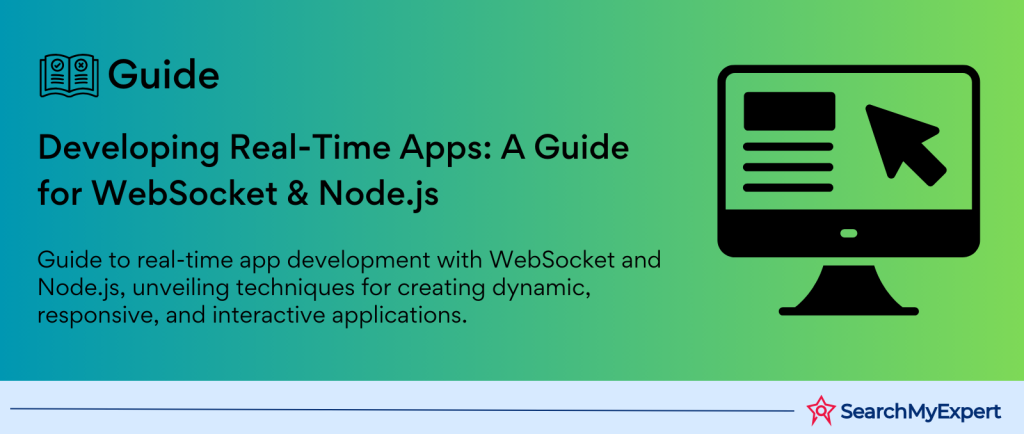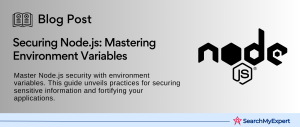WebSockets and Their Integration with Node.js
What are WebSockets?
WebSockets represent a pivotal advancement in web technologies, providing a full-duplex communication channel over a single, long-lived connection. This protocol facilitates real-time data exchange between a client and a server, allowing them to send messages independently. The significance of WebSockets lies in their ability to enable instant interactions, making them an essential technology for developing live chat applications, real-time feeds, and interactive games.
Why Use WebSockets with Node.js?
Node.js, with its non-blocking, event-driven architecture, stands out as an ideal environment for implementing WebSockets. This synergy allows developers to harness the full potential of real-time data communication, leveraging Node.js’s efficiency in handling concurrent connections and its ability to process high volumes of data with minimal overhead. By integrating WebSockets with Node.js, developers can build scalable, high-performance applications that support seamless, bidirectional communication between clients and servers.
Benefits of Using WebSockets
- Real-Time Data Transfer: WebSockets eliminate the latency associated with traditional HTTP requests, enabling instant data flow.
- Reduced Overhead:
Unlike HTTP, which requires a new connection for each request, WebSockets maintain a single connection, significantly reducing overhead. - Full-Duplex Communication: WebSockets allow both the client and server to send data simultaneously, enhancing interaction and responsiveness.
- Scalability: The efficiency of WebSockets in handling connections makes it easier to scale applications to support thousands of simultaneous users.
Drawbacks of Using WebSockets
- Complexity in Implementation:
Establishing a WebSocket connection involves more complexity compared to standard HTTP requests. - Compatibility Issues: Older browsers and web infrastructures may not fully support WebSockets, leading to compatibility challenges.
- Security Concerns:
Maintaining an open connection can introduce security risks, requiring robust authentication and encryption mechanisms to ensure data integrity and confidentiality.
Setting Up the Node.js Environment for WebSocket Development
When venturing into the realm of real-time web applications with WebSockets and Node.js, the initial setup is a critical step. This guide will cover the essentials: installing Node.js and npm, choosing the right WebSocket library, and initializing a basic Node.js project. These foundational elements lay the groundwork for building dynamic, interactive applications that can communicate in real time.
Installing Node.js and npm
Before diving into the world of WebSockets, the first order of business is to ensure that Node.js and npm (Node Package Manager) are installed on your development machine. Node.js is the backbone of your server-side application, while npm is the tool that will manage your project’s dependencies.
Installation Steps:
- Download Node.js: Visit the
official Node.js website to download the installer for your operating system. Opt for the LTS (Long Term Support) version to ensure stability and compatibility. - Install Node.js and npm:
Run the downloaded installer, following the on-screen instructions. This process will install both Node.js and npm, setting you up for development. - Verify Installation: To confirm that the installation was successful, open your terminal or command prompt and enter the following commands:
- For Node.js: node -v
- For npm: npm -v
- The terminal should display the version numbers, indicating that Node.js and npm are ready for use.
Choosing a WebSocket Library
With Node.js and npm in place, the next step is selecting an appropriate WebSocket library. The Node.js ecosystem offers several libraries tailored for WebSocket communication; the most prominent among them are ws and socket.io.
- ws:
A lightweight library that provides the bare essentials for WebSocket communication. It’s ideal for developers seeking a minimalistic approach. - socket.io:
Offers a more feature-rich environment, with built-in functionalities like fallback options for older browsers, room management, and automatic reconnection. This makes it suitable for more complex applications.
Creating a WebSocket Server with Node.js
The creation of a WebSocket server is a pivotal step in enabling real-time, bidirectional communication between clients and a server. This stage involves writing server-side code to handle WebSocket connections, including the processes of establishing connections, as well as sending and receiving messages. Let’s dive into the specifics of setting up a WebSocket server using Node.js.
Setting Up the Server Code
The initial step in crafting a WebSocket server is to establish the server code framework. This involves selecting a WebSocket library that complements Node.js, such as ws for a minimalistic approach or socket.io for a more feature-rich solution. These libraries facilitate the handling of WebSocket connections, offering a simplified API to manage the complexities of real-time communication.
Key Components of Server Setup:
- Initialization:
Import your chosen WebSocket library into your Node.js application. - Server Creation:
Utilize the library to create a WebSocket server that listens for incoming connections on a specific port. - Event Handling:
Define event listeners to manage connection events, including connection establishment, message reception, and connection closure.
Handling WebSocket Connections
Once the server is up and running, the next critical task is to manage WebSocket connections. This involves writing event handlers that respond to various events, such as a client establishing a connection or sending a message.
Managing Connections:
- On Connection: Implement an event handler that triggers when a new client connection is established. This is the ideal place to initialize client-specific variables or send a welcome message.
- Connection Lifecycle:
Monitor the connection status to handle disconnections or errors gracefully, ensuring resources are properly released and connections are cleanly closed.
Sending and Receiving Messages
The core functionality of a WebSocket server lies in its ability to exchange messages with connected clients in real time. This bidirectional communication channel allows the server and clients to send messages at any time, facilitating interactive and dynamic applications.
Message Exchange Process:
- Receiving Messages:
Set up an event listener that triggers upon receiving a message from a client. This handler should process the message, which could involve parsing JSON data, and perform appropriate actions based on the message content. - Sending Messages:
Implement functionality to send messages to one or more connected clients. This could involve broadcasting messages to all clients or targeting specific clients based on certain criteria.
Building a Real-Time Application with WebSockets and Node.js
Creating a real-time application using WebSockets and Node.js is an exciting endeavor that opens up a plethora of interactive possibilities. From live chats to instant content updates, the applications of WebSockets are vast. This step will guide you through selecting a use case, designing the application logic, and implementing WebSocket functionality to bring your real-time application to life.
Choosing a Use Case for Your Application
The first step in building your application is to select a suitable use case that benefits from real-time data exchange. Consider the following popular options:
- Live Chat Application: Enables users to communicate in real-time, ideal for customer support or social networking.
- Real-Time Notifications: Sends updates or alerts instantly, such as news feeds or stock price alerts.
- Collaborative Tools: Allows multiple users to work together seamlessly, such as in document editing or drawing applications.
- Live Data Visualization:
Displays real-time data changes, useful in dashboards for monitoring systems or financial markets.
Designing the Application Logic
With a use case in mind, the next step is to outline the application logic. This involves defining the core functionalities, data flow, and interaction between the client and server.
Core Components to Consider:
- User Interface (UI):
Design a user-friendly interface that facilitates real-time interactions. For example, a chat application requires an input field for messages and a display area for the conversation history. - Server Logic: Determine how the server will handle connections, manage user sessions, and broadcast messages.
- Data Management:
Plan how data will be stored, retrieved, and updated in real-time. This might involve integrating a database with your Node.js server.
Implementing the WebSocket Functionality
Integrating WebSocket functionality is the cornerstone of building your real-time application. This involves establishing WebSocket connections between the client and server, and implementing the logic for sending and receiving messages.
Steps for Implementation:
- WebSocket Server Setup:
Utilize your chosen WebSocket library (e.g., ws or socket.io) to set up a WebSocket server in your Node.js application. This server will handle incoming WebSocket connections. - Client-Side Integration:
Implement WebSocket client logic in your application’s frontend. This typically involves using the WebSocket API to connect to the server, send messages, and listen for incoming messages. - Message Handling:
Develop the logic for handling messages on both the server and client. This includes parsing messages, executing application-specific logic (e.g., adding a message to a chat window), and responding or broadcasting messages as needed. - Real-Time Interaction: Ensure your application logic supports real-time interactions. For instance, in a chat application, messages should appear instantly without requiring page refreshes.
Error Handling and Security in WebSocket Applications
Developing a real-time application with WebSockets and Node.js involves not just creating connections and facilitating communication but also ensuring the application is robust and secure. This step focuses on handling common WebSocket errors and implementing critical security measures such as authentication and authorization. These aspects are essential for maintaining the integrity, reliability, and security of your WebSocket-based application.
Handling Common WebSocket Errors
WebSocket connections, like any network communication, are susceptible to errors and disconnections. Handling these errors gracefully is key to providing a seamless user experience.
Common WebSocket Errors Include:
- Connection Errors:
Occur when the client cannot establish a connection with the server, possibly due to network issues or server downtime. - Timeouts: Happen when a connection is lost due to inactivity or when a message does not receive a timely response.
- Payload Too Large:
Triggered when a message exceeds the maximum size accepted by the server or client.
Strategies for Error Handling:
- Reconnection Logic: Implement automatic reconnection attempts in the client-side logic. This ensures that temporary network issues do not permanently disrupt the user experience.
- Error Logging: Log errors both on the client and server sides. This helps in diagnosing issues and improving the application.
- User Feedback: Provide clear feedback to users when an error occurs. For example, display a message indicating that the application is attempting to reconnect.
Implementing Security Measures
Security is paramount in WebSocket applications, especially since they maintain open connections that could be exploited. Implementing robust security measures protects both your data and your users.
Essential Security Measures:
- Authentication and Authorization: Ensure that only authenticated users can establish WebSocket connections. Use tokens (such as JWTs) to manage session authentication and verify the identity of users connecting to your WebSocket server.
- Encryption: Use WSS (WebSocket Secure) to encrypt data transmitted over WebSocket connections. This is the WebSocket equivalent of HTTPS and is crucial for protecting sensitive data in transit.
- Validation and Sanitization: Validate and sanitize all incoming data to prevent injection attacks. This is particularly important for applications that accept user-generated content.
- Rate Limiting: Implement rate limiting to prevent abuse of your WebSocket server, such as flooding it with messages or connection requests.
Deploying Your WebSocket Application: A Comprehensive Guide
After developing your real-time WebSocket application with Node.js, the next pivotal step is deploying it to a live environment. This process makes your application accessible to users worldwide. Deployment involves selecting a hosting platform, deploying your Node.js application, and configuring the WebSocket server for optimal performance and reliability. This guide will navigate you through these crucial steps, ensuring a smooth transition from development to production.
Choosing a Hosting Platform
The choice of hosting platform is critical and depends on several factors, including scalability, cost, and the specific needs of your WebSocket application.
Popular Hosting Platforms for Node.js Applications Include:
- Heroku:
Offers easy deployment for Node.js applications, with support for WebSockets. It’s ideal for startups and small to medium projects due to its simplicity and cost-effectiveness. - AWS (Amazon Web Services): Provides a robust and scalable environment with services like EC2 and Elastic Beanstalk, suitable for applications requiring high scalability.
- DigitalOcean:
Known for its simplicity and performance, offering Droplets and App Platform services that support Node.js and WebSocket applications. - Google Cloud Platform:
Features App Engine and Compute Engine, offering scalable cloud hosting with a wide range of services.
Deploying Your Node.js Application
Deployment processes vary across platforms, but the general steps involve packaging your application, uploading it to the chosen platform, and configuring the necessary environment variables.
General Deployment Steps:
- Prepare Your Application:
Ensure your application is production-ready. This includes optimizing the code, removing development dependencies, and configuring environment variables. - Select Deployment Method: Most platforms offer multiple deployment methods, such as direct upload, Git integration, or containerization technologies like Docker.
- Upload Your Application:
Follow the platform’s guidelines to deploy your application. This may involve using a CLI (Command Line Interface), a web dashboard, or a CI/CD pipeline. - Set Environment Variables:
Configure production-specific settings, such as database URLs, API keys, and any other sensitive information, through the platform’s environment variable management system.
Mastering Real-Time Applications with WebSockets and Node.js
Building and deploying a real-time application with WebSockets and Node.js is a journey that spans from the initial setup to the final deployment in a live environment. This comprehensive guide has walked you through each critical step, providing you with the knowledge and tools needed to create dynamic, interactive applications. Let’s recap the key points and explore resources for further learning.
Recap of Key Points
- Introduction to WebSockets:
We began by exploring what WebSockets are and why they are a pivotal technology for real-time web applications, offering benefits like reduced latency and overhead, alongside full-duplex communication. - Setting Up the Node.js Environment:
The foundation of any WebSocket application involves installing Node.js and npm, choosing a WebSocket library (e.g., ws or socket.io), and initializing a basic project structure. - Creating a WebSocket Server:
We delved into setting up a WebSocket server in Node.js, handling connections, and managing the flow of messages between the server and clients. - Building a Real-Time Application: Choosing a use case for your application was the next step, followed by designing the application logic and implementing WebSocket functionality to enable real-time interactions.
- Error Handling and Security:
Ensuring your application is robust and secure is paramount. We covered common WebSocket errors and essential security measures like authentication, authorization, and encryption. - Deploying Your Application:
Finally, we discussed choosing a hosting platform, deploying your Node.js application, and configuring the WebSocket server for a live environment.
Resources for Further Learning
To continue your journey in mastering real-time applications with WebSockets and Node.js, consider exploring the following resources:
- Official Documentation:
- Node.js Documentation
- WebSocket API
- Online Courses and Tutorials:
- Node.js Real-Time Web with Socket.io on Coursera
- Real-time Applications with Node.js and WebSocket on Udemy
- Community and Forums:
- Stack Overflow for specific questions and troubleshooting.
- GitHub to explore open-source WebSocket projects and libraries.
Conclusion:
In the realm of web development, the advent of real-time applications has revolutionized the way users interact online. This comprehensive journey through the creation of real-time applications with WebSockets and Node.js has laid down a robust foundation for developers to embark on their own projects. By meticulously covering the setup, development, error handling, security, and deployment of your application, we’ve demystified the complexities surrounding real-time web communication. The potential for innovation is vast, from enhancing user experience with instant feedback to facilitating live collaborations across the globe. As you move forward, keep exploring, experimenting, and pushing the boundaries of what’s possible with WebSockets and Node.js. The future of real-time applications is bright, and now, you’re well-equipped to be part of shaping that future.
Steer your project to success with our Node JS Development Service Company.
Table of Contents
Toggle






